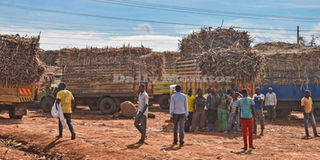Why Museveni lost Busoga to Kyagulanyi

Sugarcane trucks park at Kakira Sugar works Ltd parking yard on April 15, 2020. In Busoga, Mr Museveni got 404,862 votes, while Mr Kyagulanyi received 437,059 votes. PHOTO /FILE.
What you need to know:
- Some residents attribute Mr Museveni’s defeat to his failure to address the chronic poverty, especially the low prices for sugarcane.
The January 14 presidential elections produced some of the biggest surprises for President Museveni and his ruling National Resistance Movement (NRM) party in the last 25 years.
For the first time since his elective terms started in 1996, President Museveni last Thursday lost his traditional strongholds of Buganda and Busoga sub-regions to the Opposition.
He lost both regions to Mr Robert Kyagulanyi, alias Bobi Wine, of National Unity Platform (NUP).
Buganda, Ankole and Busoga sub-regions, the three most populous in the country, had until January 14 polls been Mr Museveni’s strongholds, accounting for up to 70 per cent of his support in previous elections.
However, results from Thursday’s polls show that Mr Museveni was only left with Ankole.
Busoga
In Busoga, Mr Museveni got 404,862 votes, while Mr Kyagulanyi received 437,059 votes.
Mr Kyagulanyi, who was contesting for presidency for the first time beat Mr Museveni, who was seeking re-election for the sixth time, by a margin of 32,197 votes.
Mr Museveni won in only three of Busoga’s 11 districts. He won in Buyende, Kaliro and Namutumba, but suffered defeat in Kamuli, Luuka, Iganga, Jinja, Bugweri, Bugiri, Namayingo and Mayuge districts.
There have been several unresolved grievances that cost Mr Museveni local support.
A section of residents who talked to Daily Monitor attributed Mr Museveni’s defeat to his failure to address the chronic poverty, especially the low prices for sugarcane.
Sugarcane question
The good prices that the local companies such as Kakira Sugar Limited and GM Sugar, were paying for cane in Busoga between 2014 and 2016 sparked a mass exodus. Farmers shifted to sugarcane growing.
Sugarcane takes between 16 and 18 months to mature.
However, by 2018, Busoga had surplus cane that the price per tonne shrank from Shs180,000 to Shs120,000 and diminished further to Shs110,000 in July 2019. By the end of last year, the price had again dropped to Shs94,000.
The biggest challenge was that the local companies do not have the capacity to process the available cane.
In 2019, Mr Museveni promised that government would construct a sugar mill in Busoga to absorb the excess sugarcane but the plant has never been built.
“The companies are coerced by government officials, army officers, etc. (To) these they give permits… who later come to us the farmers and buy cane cheaply as we have no option. They then sell to the factories at a good price,” Mr Siraje Waiswa, a farmer in Mayuge, told Daily Monitor.
The speculators usually buy the cane for as low as Shs60,000 per tonne and sell to the mills at Shs94,000. Farmers have also been frustrated and angry with government for failure to intervene.
The chairperson of Uganda Sugar Manufacturers Association (USMA), Mr Mwine Jim Kabeho, said the problem would have been mitigated by the introduction of zoning, which would have bound farmers in a particular locality to sell their cane to millers within the same zone.
He, however, added that the proposal was thrown out during the debate on the Sugar Bill in Parliament.
“There are so many people who had grown cane, but did not register with us or any other mill given that Parliament decided that farmers should be free to sell to whoever they want. Kakira, however, cannot buy cane from unregistered farmers because it becomes hard to track it for maturity,” Mr Kabeho said.
Mr Ibra Ikaata, a local farmer, said each acre of sugarcane yields at least 40 tonnes. This means middlemen get at least Shs400,000 for cane from every acre, exploiting the farmer who does the bulk of work on the fields and has to wait for 18 months to receive only Shs3,440,000.
There are other grievances that worked against President Museveni, especially unfulfilled promises.
There is a long outstanding pledge to install a ferry on Lake Kyoga at Bukungu that would open up Busoga to Lango and Teso sub-regions for business and other economic opportunities. The tarmacking of the 58km Kamuli-Bukungu road, which has appeared in the national budget for 15 years, has not been fulfilled.
“Museveni’s promises have turned political lies. The road network would appeal to every voter and change their livelihood. Our only choice was to make our voice heard through the ballot,” Mr Joshua Isabirye, a voter in Kibuyu, Kamuli District, says.
In the last 30 years, NRM has upgraded only one major road in Busoga-- Musita-Mayuge-Mayinja road, which the President commissioned recently. The Jinja-Kamuli road was only rehabilitated.
Army deployment on the lake
Busoga is surrounded by lakes Kyoga, Victoria and River Nile and fishing is one of the biggest economic activities in the sub-region.
However, fishermen have in recent years been brutalised and banned from the waters by UPDF soldiers, who were deployed to regulate illegal fishing. This has deprived the fishing communities of their main source of livelihood and employment.
Musumba candidature
In Kamuli and Buyende, the residents accuse Mr Museveni of not doing enough to protect their own and Speaker of Parliament Rebecca Kadaga. Many voters claim junior Minister for Lands Persis Namuganza’s attempt to unseat Kadaga from the NRM Central Executive Committee (CEC) and the candidature of Ms Salaamu Musumba in the Thursday elections were sponsored by people close to Mr Museveni.
“Ms Musumbu was merely used by NRM, which imported rifts and schemed their mission to stop Kadaga,” Mr Tito Ikanga, a local businessman and voter in Kitayunjwa, Kamuli, said.
Ms Musumba, however denied being sponsored to bring down Ms Kadaga.
Compiled by Opio Sam Caleb, Elizabeth Kamurungi, & Isaac Mufumba




